Evaluating the Impact of Clean Air Policies in Texas
VerifiedAdded on 2020/04/15
|8
|1992
|273
AI Summary
The analysis delves into the implementation of environmental policies aimed at reducing air pollution in Texas. It evaluates the role of the Clean Air Act and the Texas Commission on Environmental Quality (TCEQ) in mitigating pollutants from refineries and chemical plants that have adversely impacted public health. Despite facing criticism, these entities have played a crucial part in enforcing regulations to limit emissions causing respiratory issues like asthma and cancer. The study also considers how federal interventions by the EPA have complemented state efforts in enhancing air quality. Challenges such as regulatory resistance and enforcement inefficiencies are discussed. Ultimately, the analysis emphasizes the need for further policy development and stricter enforcement to achieve significant reductions in environmental pollution.

Running head: ENVIRONMENTAL POLICY AND AIR POLLUTION IN TEXAS
Environmental policy and air pollution in Texas
Name of the student
Name of the university
Author note
Environmental policy and air pollution in Texas
Name of the student
Name of the university
Author note
Paraphrase This Document
Need a fresh take? Get an instant paraphrase of this document with our AI Paraphraser
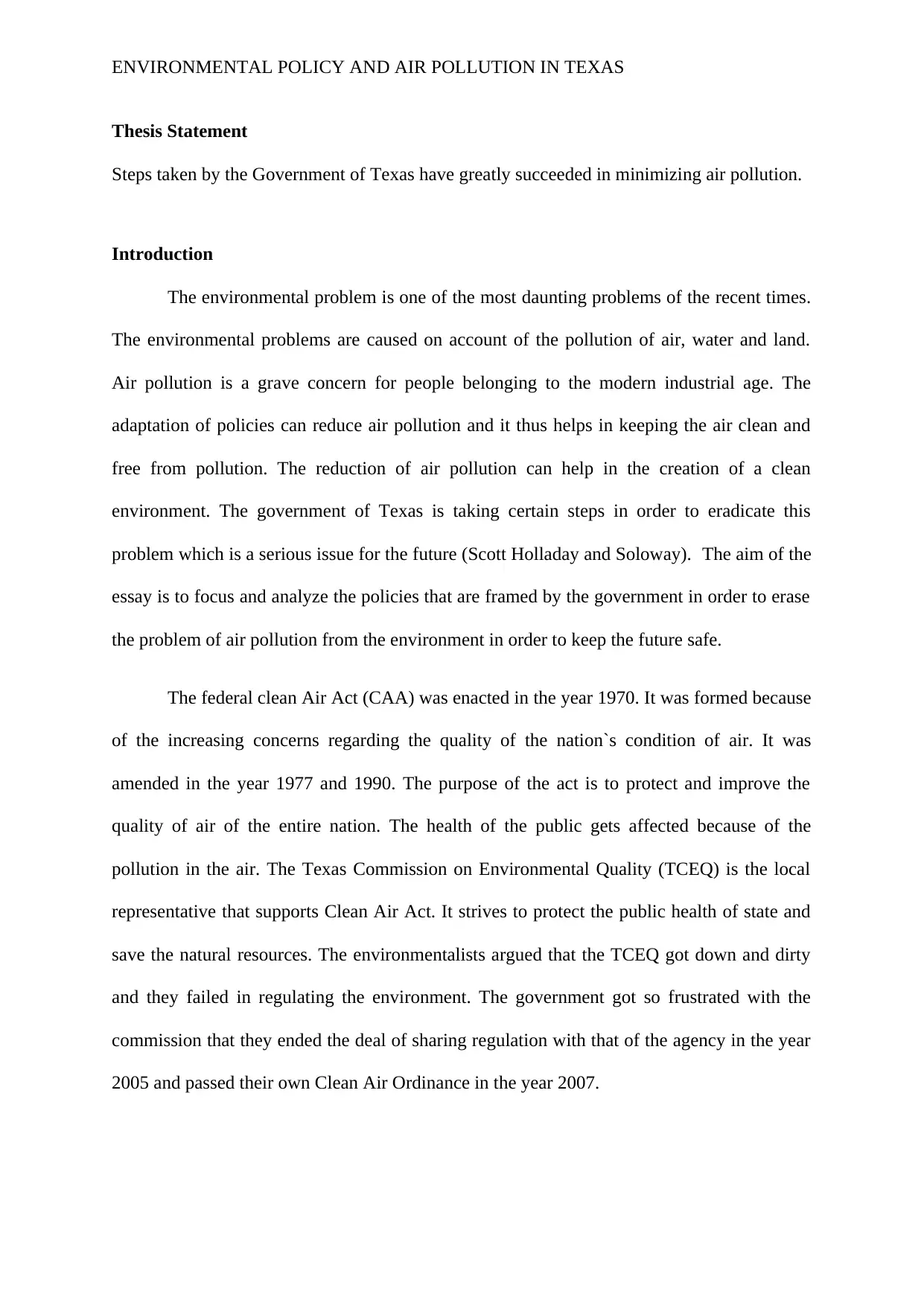
ENVIRONMENTAL POLICY AND AIR POLLUTION IN TEXAS
Thesis Statement
Steps taken by the Government of Texas have greatly succeeded in minimizing air pollution.
Introduction
The environmental problem is one of the most daunting problems of the recent times.
The environmental problems are caused on account of the pollution of air, water and land.
Air pollution is a grave concern for people belonging to the modern industrial age. The
adaptation of policies can reduce air pollution and it thus helps in keeping the air clean and
free from pollution. The reduction of air pollution can help in the creation of a clean
environment. The government of Texas is taking certain steps in order to eradicate this
problem which is a serious issue for the future (Scott Holladay and Soloway). The aim of the
essay is to focus and analyze the policies that are framed by the government in order to erase
the problem of air pollution from the environment in order to keep the future safe.
The federal clean Air Act (CAA) was enacted in the year 1970. It was formed because
of the increasing concerns regarding the quality of the nation`s condition of air. It was
amended in the year 1977 and 1990. The purpose of the act is to protect and improve the
quality of air of the entire nation. The health of the public gets affected because of the
pollution in the air. The Texas Commission on Environmental Quality (TCEQ) is the local
representative that supports Clean Air Act. It strives to protect the public health of state and
save the natural resources. The environmentalists argued that the TCEQ got down and dirty
and they failed in regulating the environment. The government got so frustrated with the
commission that they ended the deal of sharing regulation with that of the agency in the year
2005 and passed their own Clean Air Ordinance in the year 2007.
Thesis Statement
Steps taken by the Government of Texas have greatly succeeded in minimizing air pollution.
Introduction
The environmental problem is one of the most daunting problems of the recent times.
The environmental problems are caused on account of the pollution of air, water and land.
Air pollution is a grave concern for people belonging to the modern industrial age. The
adaptation of policies can reduce air pollution and it thus helps in keeping the air clean and
free from pollution. The reduction of air pollution can help in the creation of a clean
environment. The government of Texas is taking certain steps in order to eradicate this
problem which is a serious issue for the future (Scott Holladay and Soloway). The aim of the
essay is to focus and analyze the policies that are framed by the government in order to erase
the problem of air pollution from the environment in order to keep the future safe.
The federal clean Air Act (CAA) was enacted in the year 1970. It was formed because
of the increasing concerns regarding the quality of the nation`s condition of air. It was
amended in the year 1977 and 1990. The purpose of the act is to protect and improve the
quality of air of the entire nation. The health of the public gets affected because of the
pollution in the air. The Texas Commission on Environmental Quality (TCEQ) is the local
representative that supports Clean Air Act. It strives to protect the public health of state and
save the natural resources. The environmentalists argued that the TCEQ got down and dirty
and they failed in regulating the environment. The government got so frustrated with the
commission that they ended the deal of sharing regulation with that of the agency in the year
2005 and passed their own Clean Air Ordinance in the year 2007.
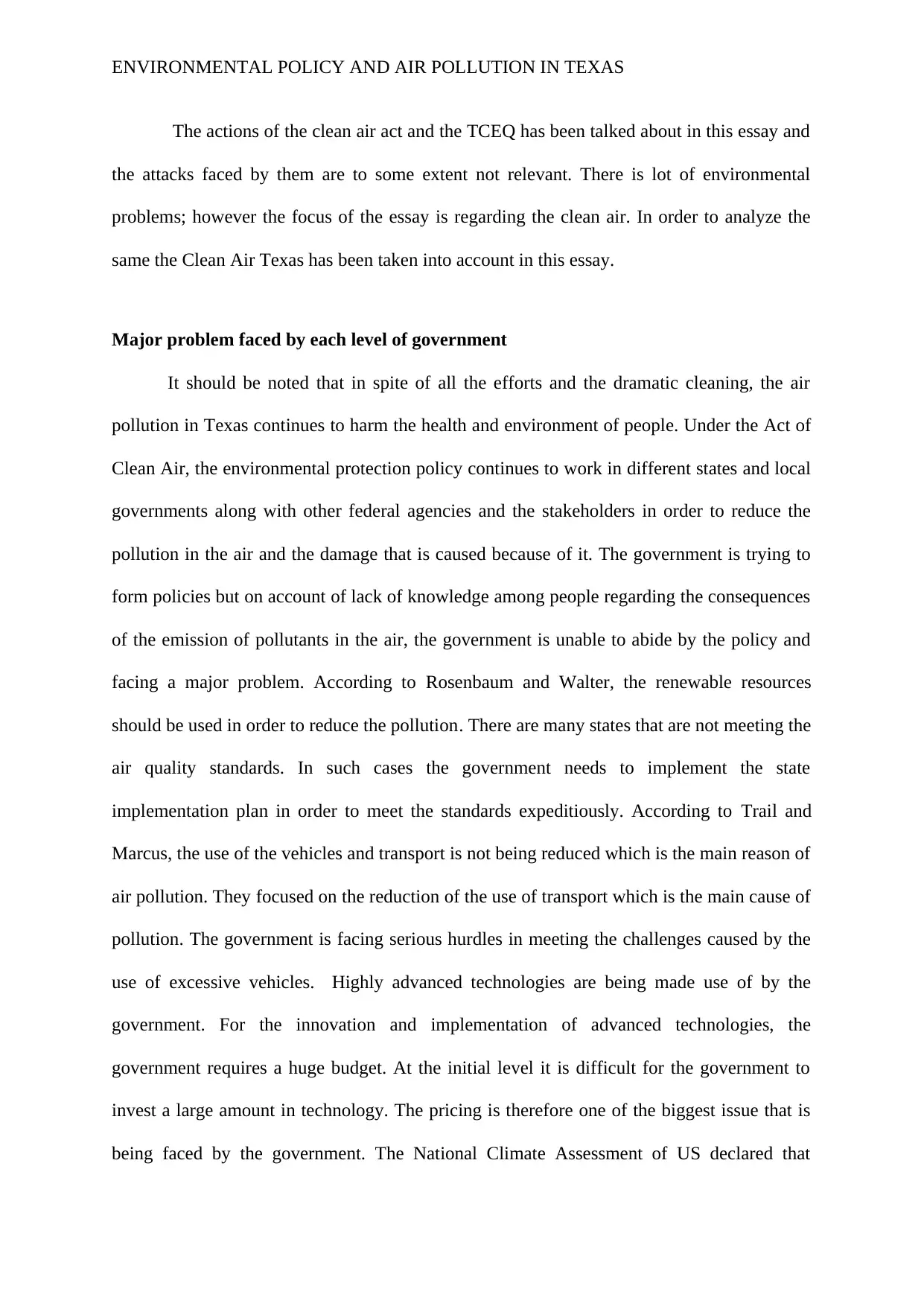
ENVIRONMENTAL POLICY AND AIR POLLUTION IN TEXAS
The actions of the clean air act and the TCEQ has been talked about in this essay and
the attacks faced by them are to some extent not relevant. There is lot of environmental
problems; however the focus of the essay is regarding the clean air. In order to analyze the
same the Clean Air Texas has been taken into account in this essay.
Major problem faced by each level of government
It should be noted that in spite of all the efforts and the dramatic cleaning, the air
pollution in Texas continues to harm the health and environment of people. Under the Act of
Clean Air, the environmental protection policy continues to work in different states and local
governments along with other federal agencies and the stakeholders in order to reduce the
pollution in the air and the damage that is caused because of it. The government is trying to
form policies but on account of lack of knowledge among people regarding the consequences
of the emission of pollutants in the air, the government is unable to abide by the policy and
facing a major problem. According to Rosenbaum and Walter, the renewable resources
should be used in order to reduce the pollution. There are many states that are not meeting the
air quality standards. In such cases the government needs to implement the state
implementation plan in order to meet the standards expeditiously. According to Trail and
Marcus, the use of the vehicles and transport is not being reduced which is the main reason of
air pollution. They focused on the reduction of the use of transport which is the main cause of
pollution. The government is facing serious hurdles in meeting the challenges caused by the
use of excessive vehicles. Highly advanced technologies are being made use of by the
government. For the innovation and implementation of advanced technologies, the
government requires a huge budget. At the initial level it is difficult for the government to
invest a large amount in technology. The pricing is therefore one of the biggest issue that is
being faced by the government. The National Climate Assessment of US declared that
The actions of the clean air act and the TCEQ has been talked about in this essay and
the attacks faced by them are to some extent not relevant. There is lot of environmental
problems; however the focus of the essay is regarding the clean air. In order to analyze the
same the Clean Air Texas has been taken into account in this essay.
Major problem faced by each level of government
It should be noted that in spite of all the efforts and the dramatic cleaning, the air
pollution in Texas continues to harm the health and environment of people. Under the Act of
Clean Air, the environmental protection policy continues to work in different states and local
governments along with other federal agencies and the stakeholders in order to reduce the
pollution in the air and the damage that is caused because of it. The government is trying to
form policies but on account of lack of knowledge among people regarding the consequences
of the emission of pollutants in the air, the government is unable to abide by the policy and
facing a major problem. According to Rosenbaum and Walter, the renewable resources
should be used in order to reduce the pollution. There are many states that are not meeting the
air quality standards. In such cases the government needs to implement the state
implementation plan in order to meet the standards expeditiously. According to Trail and
Marcus, the use of the vehicles and transport is not being reduced which is the main reason of
air pollution. They focused on the reduction of the use of transport which is the main cause of
pollution. The government is facing serious hurdles in meeting the challenges caused by the
use of excessive vehicles. Highly advanced technologies are being made use of by the
government. For the innovation and implementation of advanced technologies, the
government requires a huge budget. At the initial level it is difficult for the government to
invest a large amount in technology. The pricing is therefore one of the biggest issue that is
being faced by the government. The National Climate Assessment of US declared that
⊘ This is a preview!⊘
Do you want full access?
Subscribe today to unlock all pages.

Trusted by 1+ million students worldwide

ENVIRONMENTAL POLICY AND AIR POLLUTION IN TEXAS
climate change impacts are manifesting themselves and creating major barriers in resolving
the crisis caused by air pollution. However in order to overcome such problems, the
government of Texas has adopted certain policies and plans. This has been stated by
Tietenberg, Thomas H and Lynne Lewis that the policies have been implemented in order to
reduce the factors that are leading to the air pollution.
Reason for initiating changes to the policy
The major reason for initiating changes to the policy was that The Environmental
protection Agency exponentially expanded the regulation under the Clean Air Act at the
expense to the Americans. According to Novan and Kevin, the State have robbed their role in
the protection of environment. Therefore, the government implemented certain rules that
consisted of legislation, the budget process and the oversight powers that would constrain the
regulatory abuses of EPA. There was a technical risk in relation to the assessment of the
regulatory impact with which the EPA justifies certain rules and regulations. The abuse of the
policy served as the major reason for initiating a change to the policy.
Options to be considered
In order to eradicate the problems related to the amendment of the policy the
government has joined hands with EPA. This was formed to regulate the Clean Air Act. The
first and foremost option was to restate and clarify in law the fact that the Clean Air Act was
not designed to regulate the greenhouse gases. This option needs to be considered
immediately. It should be kept in mind that the emission applies to the individual stationary
industrial units and not to an entire industrial sector or any state. However, this option needs
to be considered. The option of legality of the carbon rules for the new and existing power
plants needs to be revised (Kraft and Michael).
climate change impacts are manifesting themselves and creating major barriers in resolving
the crisis caused by air pollution. However in order to overcome such problems, the
government of Texas has adopted certain policies and plans. This has been stated by
Tietenberg, Thomas H and Lynne Lewis that the policies have been implemented in order to
reduce the factors that are leading to the air pollution.
Reason for initiating changes to the policy
The major reason for initiating changes to the policy was that The Environmental
protection Agency exponentially expanded the regulation under the Clean Air Act at the
expense to the Americans. According to Novan and Kevin, the State have robbed their role in
the protection of environment. Therefore, the government implemented certain rules that
consisted of legislation, the budget process and the oversight powers that would constrain the
regulatory abuses of EPA. There was a technical risk in relation to the assessment of the
regulatory impact with which the EPA justifies certain rules and regulations. The abuse of the
policy served as the major reason for initiating a change to the policy.
Options to be considered
In order to eradicate the problems related to the amendment of the policy the
government has joined hands with EPA. This was formed to regulate the Clean Air Act. The
first and foremost option was to restate and clarify in law the fact that the Clean Air Act was
not designed to regulate the greenhouse gases. This option needs to be considered
immediately. It should be kept in mind that the emission applies to the individual stationary
industrial units and not to an entire industrial sector or any state. However, this option needs
to be considered. The option of legality of the carbon rules for the new and existing power
plants needs to be revised (Kraft and Michael).
Paraphrase This Document
Need a fresh take? Get an instant paraphrase of this document with our AI Paraphraser

ENVIRONMENTAL POLICY AND AIR POLLUTION IN TEXAS
Pros and cones
There are pros and cones in relation to the cost of the policies. The tax regarding the
pollution which is known as the carbon tax requires people to pay the social cost of pollution.
This has been put forward by Wolch, Jennifer R., Jason Byrne and Joshua P. Newell
that the pollution permits like the carbon trading schemes are provided to the firms that
enables them to cause pollution to a certain extent. These permits prove to be difficult to be
traded with the other firms.
The major hurdle in the relation of implementing these policies is owing to the
awareness among the people. The people are ignorant about the adverse effects that are
caused on account of air pollution. Therefore it was proving to be difficult to convince people
and the implementation of the pollution tax was difficult. This was proving to be a major
difficulty in implementing the policies and the pricing of it. Therefore, it suffered from the
benefits of the cost. This has been presented in the works of Fry, Matthew, Adam Briggle and
Jordan Kincaid.
Best option moving forward
The best option is to implement the Clean Air Act. It is done in order to restore the
rationality and the accountability to the environmental protection (Sheehan-Connor). The
abuse of regulatory power and the re-establishment of the authority of law-makers have been
rectified to set the environment and energy policy better. This particular act can restore a
pollution free environment and erase the source of the emission. Therefore, it has been put
forward by Anderson and Frederick, that the act is the best step that can be taken in order to
create a pollution free environment.
Pros and cones
There are pros and cones in relation to the cost of the policies. The tax regarding the
pollution which is known as the carbon tax requires people to pay the social cost of pollution.
This has been put forward by Wolch, Jennifer R., Jason Byrne and Joshua P. Newell
that the pollution permits like the carbon trading schemes are provided to the firms that
enables them to cause pollution to a certain extent. These permits prove to be difficult to be
traded with the other firms.
The major hurdle in the relation of implementing these policies is owing to the
awareness among the people. The people are ignorant about the adverse effects that are
caused on account of air pollution. Therefore it was proving to be difficult to convince people
and the implementation of the pollution tax was difficult. This was proving to be a major
difficulty in implementing the policies and the pricing of it. Therefore, it suffered from the
benefits of the cost. This has been presented in the works of Fry, Matthew, Adam Briggle and
Jordan Kincaid.
Best option moving forward
The best option is to implement the Clean Air Act. It is done in order to restore the
rationality and the accountability to the environmental protection (Sheehan-Connor). The
abuse of regulatory power and the re-establishment of the authority of law-makers have been
rectified to set the environment and energy policy better. This particular act can restore a
pollution free environment and erase the source of the emission. Therefore, it has been put
forward by Anderson and Frederick, that the act is the best step that can be taken in order to
create a pollution free environment.
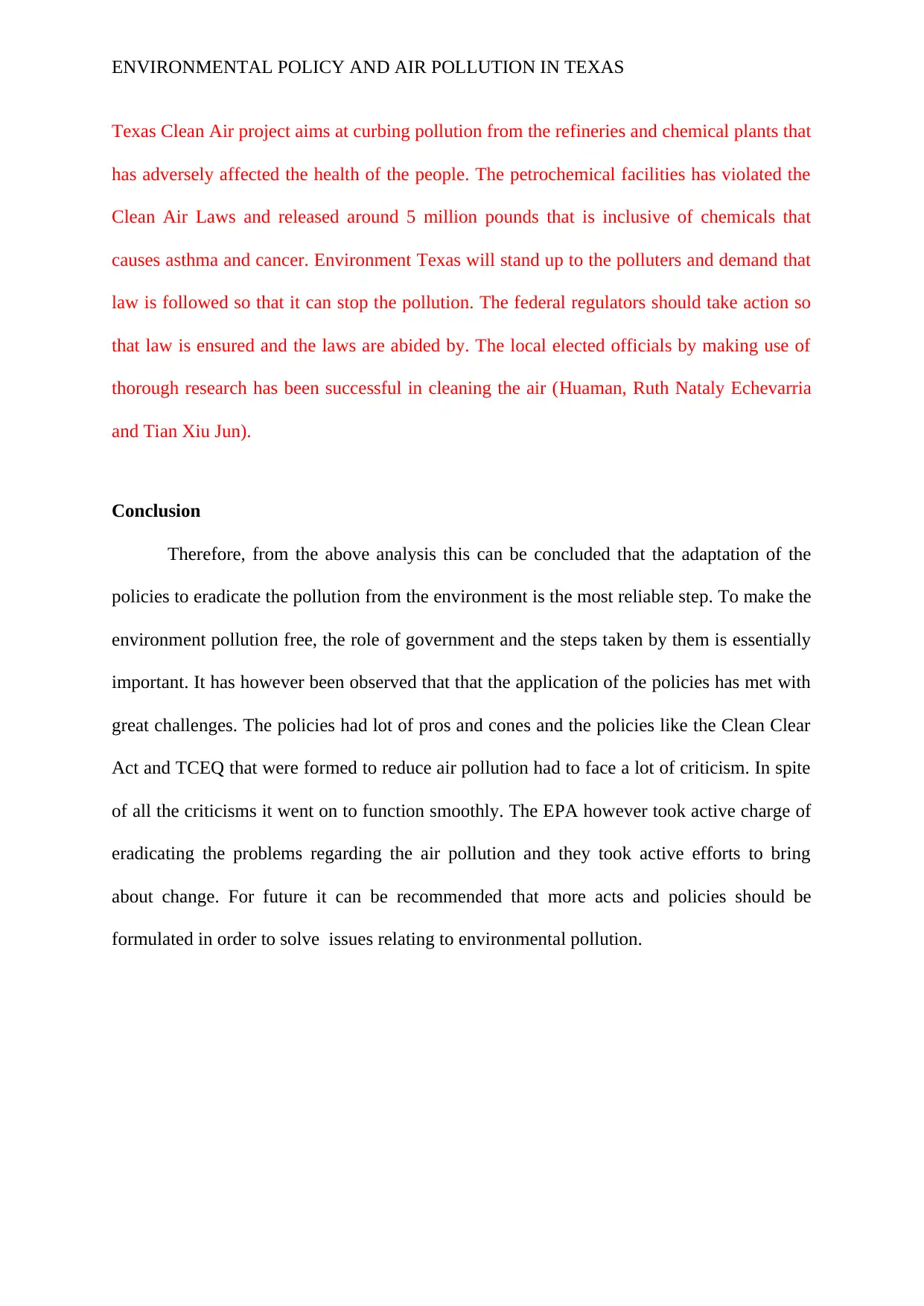
ENVIRONMENTAL POLICY AND AIR POLLUTION IN TEXAS
Texas Clean Air project aims at curbing pollution from the refineries and chemical plants that
has adversely affected the health of the people. The petrochemical facilities has violated the
Clean Air Laws and released around 5 million pounds that is inclusive of chemicals that
causes asthma and cancer. Environment Texas will stand up to the polluters and demand that
law is followed so that it can stop the pollution. The federal regulators should take action so
that law is ensured and the laws are abided by. The local elected officials by making use of
thorough research has been successful in cleaning the air (Huaman, Ruth Nataly Echevarria
and Tian Xiu Jun).
Conclusion
Therefore, from the above analysis this can be concluded that the adaptation of the
policies to eradicate the pollution from the environment is the most reliable step. To make the
environment pollution free, the role of government and the steps taken by them is essentially
important. It has however been observed that that the application of the policies has met with
great challenges. The policies had lot of pros and cones and the policies like the Clean Clear
Act and TCEQ that were formed to reduce air pollution had to face a lot of criticism. In spite
of all the criticisms it went on to function smoothly. The EPA however took active charge of
eradicating the problems regarding the air pollution and they took active efforts to bring
about change. For future it can be recommended that more acts and policies should be
formulated in order to solve issues relating to environmental pollution.
Texas Clean Air project aims at curbing pollution from the refineries and chemical plants that
has adversely affected the health of the people. The petrochemical facilities has violated the
Clean Air Laws and released around 5 million pounds that is inclusive of chemicals that
causes asthma and cancer. Environment Texas will stand up to the polluters and demand that
law is followed so that it can stop the pollution. The federal regulators should take action so
that law is ensured and the laws are abided by. The local elected officials by making use of
thorough research has been successful in cleaning the air (Huaman, Ruth Nataly Echevarria
and Tian Xiu Jun).
Conclusion
Therefore, from the above analysis this can be concluded that the adaptation of the
policies to eradicate the pollution from the environment is the most reliable step. To make the
environment pollution free, the role of government and the steps taken by them is essentially
important. It has however been observed that that the application of the policies has met with
great challenges. The policies had lot of pros and cones and the policies like the Clean Clear
Act and TCEQ that were formed to reduce air pollution had to face a lot of criticism. In spite
of all the criticisms it went on to function smoothly. The EPA however took active charge of
eradicating the problems regarding the air pollution and they took active efforts to bring
about change. For future it can be recommended that more acts and policies should be
formulated in order to solve issues relating to environmental pollution.
⊘ This is a preview!⊘
Do you want full access?
Subscribe today to unlock all pages.

Trusted by 1+ million students worldwide
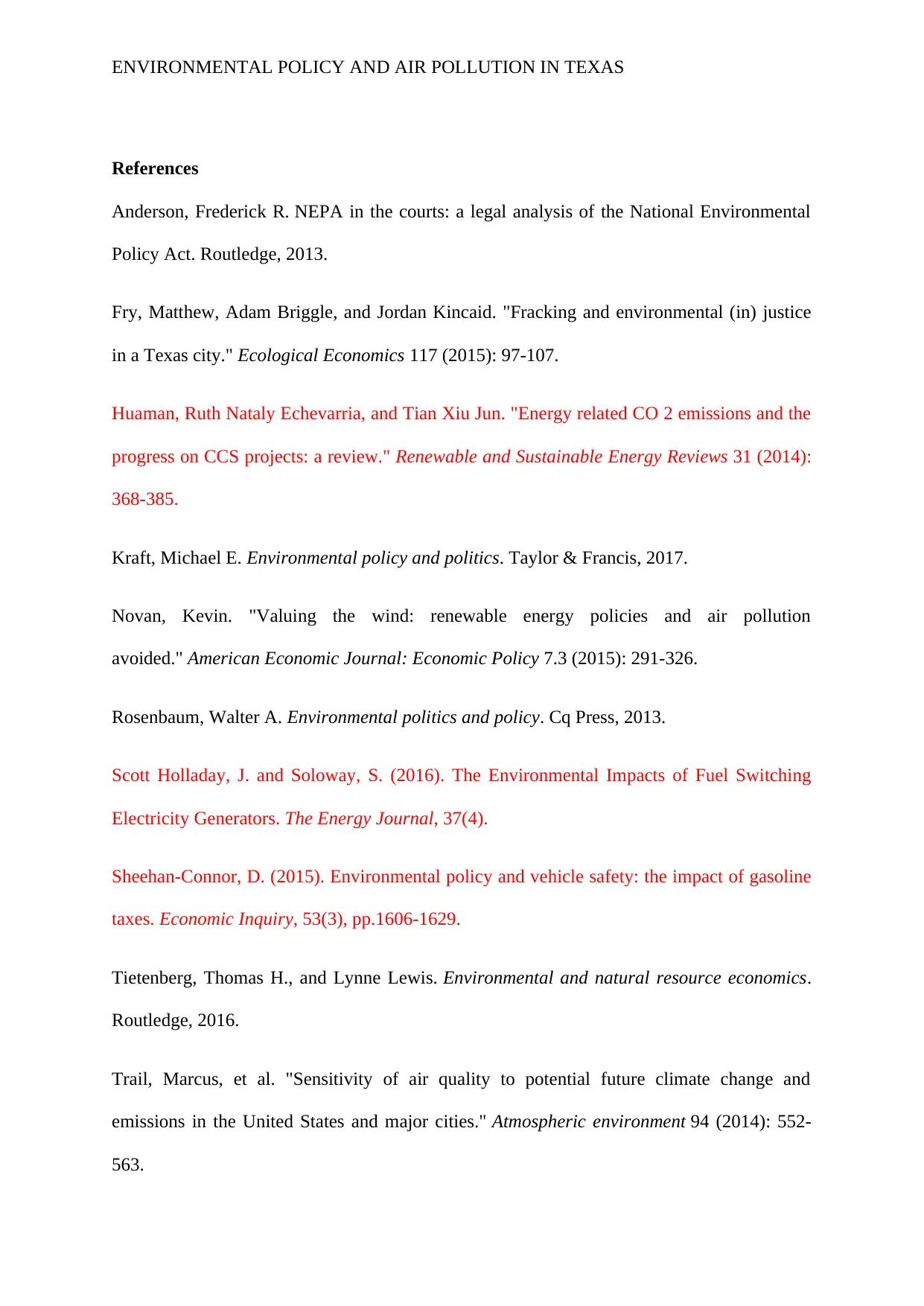
ENVIRONMENTAL POLICY AND AIR POLLUTION IN TEXAS
References
Anderson, Frederick R. NEPA in the courts: a legal analysis of the National Environmental
Policy Act. Routledge, 2013.
Fry, Matthew, Adam Briggle, and Jordan Kincaid. "Fracking and environmental (in) justice
in a Texas city." Ecological Economics 117 (2015): 97-107.
Huaman, Ruth Nataly Echevarria, and Tian Xiu Jun. "Energy related CO 2 emissions and the
progress on CCS projects: a review." Renewable and Sustainable Energy Reviews 31 (2014):
368-385.
Kraft, Michael E. Environmental policy and politics. Taylor & Francis, 2017.
Novan, Kevin. "Valuing the wind: renewable energy policies and air pollution
avoided." American Economic Journal: Economic Policy 7.3 (2015): 291-326.
Rosenbaum, Walter A. Environmental politics and policy. Cq Press, 2013.
Scott Holladay, J. and Soloway, S. (2016). The Environmental Impacts of Fuel Switching
Electricity Generators. The Energy Journal, 37(4).
Sheehan-Connor, D. (2015). Environmental policy and vehicle safety: the impact of gasoline
taxes. Economic Inquiry, 53(3), pp.1606-1629.
Tietenberg, Thomas H., and Lynne Lewis. Environmental and natural resource economics.
Routledge, 2016.
Trail, Marcus, et al. "Sensitivity of air quality to potential future climate change and
emissions in the United States and major cities." Atmospheric environment 94 (2014): 552-
563.
References
Anderson, Frederick R. NEPA in the courts: a legal analysis of the National Environmental
Policy Act. Routledge, 2013.
Fry, Matthew, Adam Briggle, and Jordan Kincaid. "Fracking and environmental (in) justice
in a Texas city." Ecological Economics 117 (2015): 97-107.
Huaman, Ruth Nataly Echevarria, and Tian Xiu Jun. "Energy related CO 2 emissions and the
progress on CCS projects: a review." Renewable and Sustainable Energy Reviews 31 (2014):
368-385.
Kraft, Michael E. Environmental policy and politics. Taylor & Francis, 2017.
Novan, Kevin. "Valuing the wind: renewable energy policies and air pollution
avoided." American Economic Journal: Economic Policy 7.3 (2015): 291-326.
Rosenbaum, Walter A. Environmental politics and policy. Cq Press, 2013.
Scott Holladay, J. and Soloway, S. (2016). The Environmental Impacts of Fuel Switching
Electricity Generators. The Energy Journal, 37(4).
Sheehan-Connor, D. (2015). Environmental policy and vehicle safety: the impact of gasoline
taxes. Economic Inquiry, 53(3), pp.1606-1629.
Tietenberg, Thomas H., and Lynne Lewis. Environmental and natural resource economics.
Routledge, 2016.
Trail, Marcus, et al. "Sensitivity of air quality to potential future climate change and
emissions in the United States and major cities." Atmospheric environment 94 (2014): 552-
563.
Paraphrase This Document
Need a fresh take? Get an instant paraphrase of this document with our AI Paraphraser
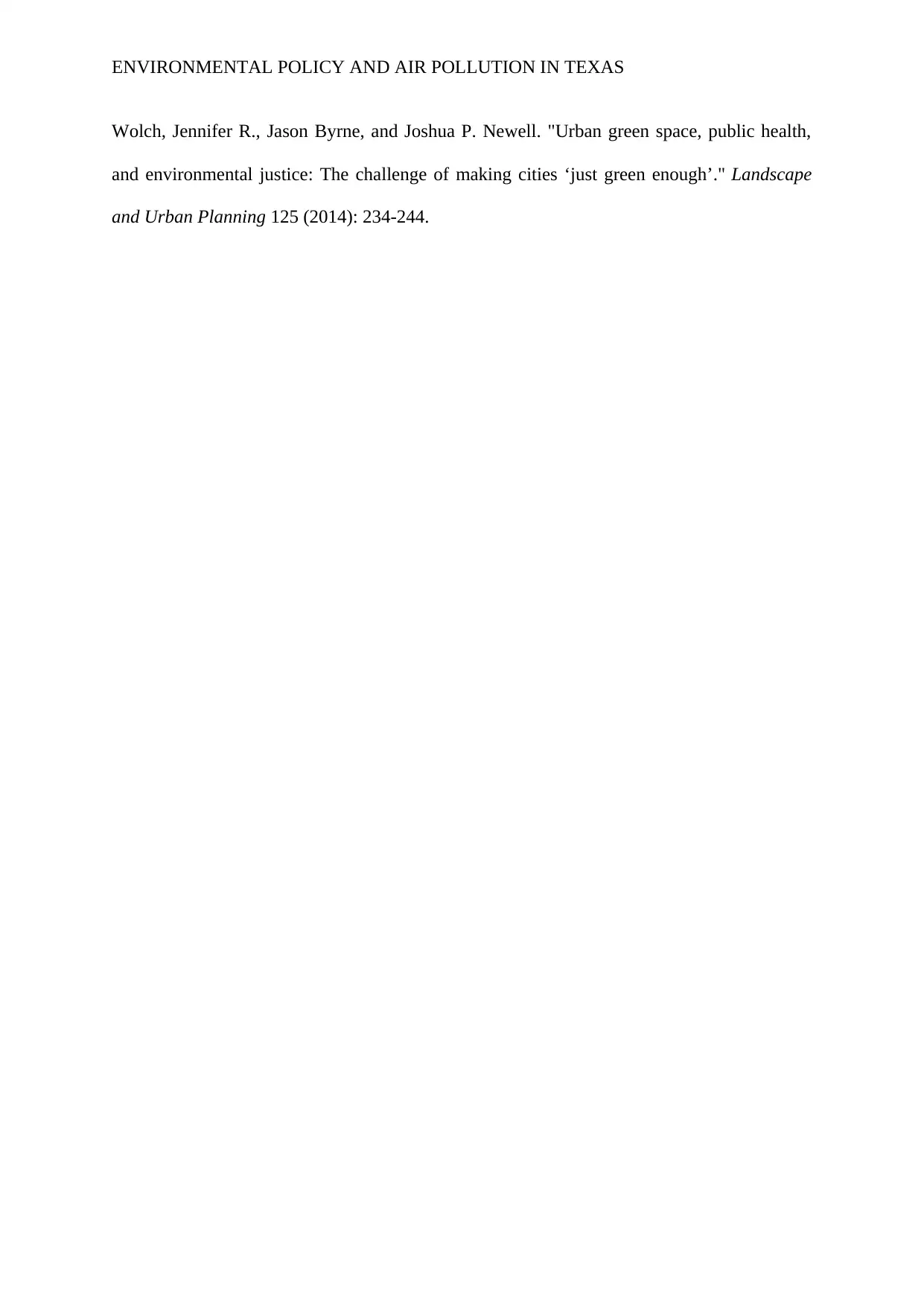
ENVIRONMENTAL POLICY AND AIR POLLUTION IN TEXAS
Wolch, Jennifer R., Jason Byrne, and Joshua P. Newell. "Urban green space, public health,
and environmental justice: The challenge of making cities ‘just green enough’." Landscape
and Urban Planning 125 (2014): 234-244.
Wolch, Jennifer R., Jason Byrne, and Joshua P. Newell. "Urban green space, public health,
and environmental justice: The challenge of making cities ‘just green enough’." Landscape
and Urban Planning 125 (2014): 234-244.
1 out of 8
Related Documents
Your All-in-One AI-Powered Toolkit for Academic Success.
+13062052269
info@desklib.com
Available 24*7 on WhatsApp / Email
![[object Object]](/_next/static/media/star-bottom.7253800d.svg)
Unlock your academic potential
Copyright © 2020–2025 A2Z Services. All Rights Reserved. Developed and managed by ZUCOL.





